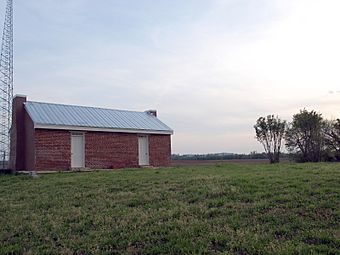Boxwood Plantation Slave Quarter facts for kids
Quick facts for kids |
|
|
Boxwood Plantation Slave Quarter
|
|

The building in April 2017
|
|
| Nearest city | Trinity, Alabama |
|---|---|
| Architectural style | Double Pen |
| NRHP reference No. | 13000470 |
| Added to NRHP | July 10, 2013 |
The Boxwood Plantation Slave Quarter (also known as The Little Brick) is a historic building near Trinity, Alabama in Lawrence County, Alabama. This building was once a home for enslaved people on a large farm called Boxwood Plantation. Today, it is being preserved to help us understand an important part of history.
Contents
What Was a Slave Quarter?
A slave quarter was a building where enslaved people lived on a plantation. Plantations were large farms, especially common in the southern United States, where crops like cotton were grown. Enslaved people were forced to work on these farms without pay and were not free. The Boxwood Plantation Slave Quarter is a rare example of a brick building used for this purpose.
History of Boxwood Plantation
Boxwood Plantation was started in the late 1810s by Samuel Elliot. He was from a place called Ulster and first settled in Middle Tennessee. Samuel Elliot and his son, Samuel Jr., worked hard to make Boxwood one of the biggest plantations in Lawrence County. By 1860, the plantation had many enslaved people working there.
Both the main house of the plantation and the slave quarters were built around the mid-1850s. These buildings were made of brick, which was unusual for plantations at that time. Most other plantation buildings were made of wood.
The Building's Journey
Over the years, many things changed at Boxwood Plantation. The main plantation house was taken down in the 1950s. This happened to make room for widening Highway 20.
However, the slave quarter building was saved. It was changed and used as a regular house for many years. The land around it continued to be a farm until 2010. After that, the land was bought to build an industrial park.
Preserving History
Today, the Boxwood Plantation Slave Quarter is being carefully preserved. Workers have removed the changes made to the building over the years. This helps to show what the building looked like when it was first built.
The building has a special design called "double-pen." This means it has two separate rooms, each with its own door on the front. It also has a gable roof with chimneys at each end. In the 1960s, two windows at the back of the house were changed into doors.
This building is very important because it is the only remaining slave quarter from several cotton plantations in the area. It is also one of only eight brick slave quarters known in Alabama. Because of its historical value, the building was added to the National Register of Historic Places in 2013.



